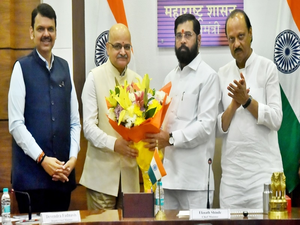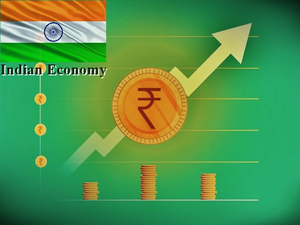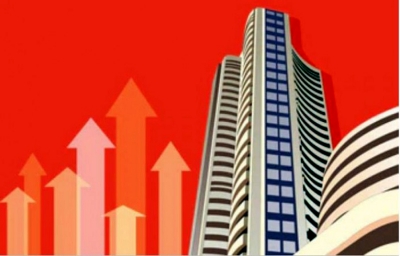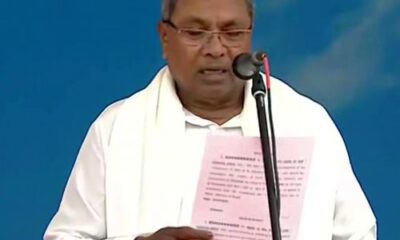Businesses
PM Modi has 50-year vision for India’s growth: Ashwini Vaishnaw (Full IANS Interview)
New Delhi, April 24 (IANS) Union Railways and IT Minister Ashwini Vaishnaw, in an exclusive conversation with IANS, expressed his views on several issues ranging from the development of Indian Railways, employment generation, vision of Prime Minister Narendra Modi, the government’s overall development plans for the next five years, Artificial Intelligence, semiconductors and investment across the technology sector.
The Union Minister answered IANS questions very candidly and also gave a message to the people of the country that in the next five years, the government plans to ensure that every person travelling by train can get a confirmed ticket.
IANS: There are talks of a bullet train. A plan has also been made and work on it is going on at a rapid pace. When can the Indian passengers get a chance to travel by bullet train?
Ashwini Vaishnaw: Significant progress has been made in the construction of various stations for India’s first bullet train and we are geared up to run the first train in one section in 2026. More than 290 kms of work has already been done. Bridges have been built over eight rivers. Work is going on at 12 stations. The stations have also come to the same level so the work is nearing completion. The work is going on at two depots. It is going on at a very fast pace with the complete target of opening its first section in 2026. The bullet train is a very complex project. The work on it started in 2017 and it took almost two-and-a-half years to complete the design. Its design is very complex because the vibrations are very strong at the speed at which the train has to run. So, how to manage those vibrations? If we have to take electricity from overhead cables then how do we take that current? Everything like speed, aerodynamics, etc. has to be looked at very carefully and the work started immediately after that. In between, there was a little setback due to the Covid pandemic. In Maharashtra, Uddhav Thackeray’s government refused to give permission which delayed the project. But the work is progressing very well now.
IANS: If seen from the point of view of ‘Viksit Bharat’, in which specific areas is the Railway Ministry working for rapid progress?
Ashwini Vaishnaw: The important target of Indian Railways is our low-income and middle-income families. To develop a good, affordable, safe, timely delivery service for them. Therefore, it was very important to increase the capacity of railways. Only by increasing the capacity of railways, more trains will be able to run and only by running more trains, people will be able to get the facilities they want. In the next five years, it is PM Modi’s guarantee that almost any passenger who wants to travel can easily get a confirmed ticket. In the last 10 years, PM Modi has done unprecedented transformation in railways. In the next five years, PM Modi’s guarantee is that the capacity of the railways will be increased so much that almost any passenger who wants to travel can easily get a confirmed ticket. To increase the capacity, if we look at the period from 2014 to 2024 and compare it with 2004 to 2014, then you will see a big difference. In the process of building railway tracks, only 17,000 kms of tracks were built between 2004 and 2014. From 2014 to 2024, 31,000 kms of new tracks were built. In the 10 years from 2004 to 2014, only around 5,000 kms were electrified, whereas in the last 10 years, a staggering 44,000 kms of railway electrification took place. Only 32,000 coaches were made from 2004-2014. In the last 10 years, 54,000 coaches were built. For the dedicated freight corridor, not even a single kilometre was commissioned before 2014. Now, two dedicated freight corridors of 2,734 kms have been commissioned. In the next five years, Indian Railways, which is a strong link in the growth of the country’s economy, will be further strengthened and the facilities, especially for the passengers, will be expanded at a much faster pace.
IANS: Promises for improvement and innovation of Indian Railways have also been made in the BJP manifesto. What are the plans for the next five years?
Ashwini Vaishnaw: The Bharatiya Janata Party has very clearly laid out the vision of railways in its manifesto for the next five years and the first is that PM Modi has guaranteed that the capacity of the railways will be expanded very rapidly in the next five years. Second, many types of new technologies will be introduced. Third, three types of Vande Bharat trains will be used for the convenience of passengers — Vande Bharat Sleeper, Vande Bharat Chair Car, and Vande Bharat Metro Car. By using these three, passengers will be provided with very good facilities. The fourth, Amrit Bharat train, will be manufactured in large numbers in the near future so that anyone can travel long distances comfortably. For ease of travel, a Super App will be created so that every facility related to all kinds of rail travel can be addressed comfortably through the app. The comprehensive Super App has been designed to serve as a one-stop solution for railway commuters. The redevelopment of 1,320 stations is going on and will be completed soon. After that, all the other medium and big stations will also be included in the station redevelopment programme.
IANS: In manufacturing, we have seen that many global companies have come to India thanks to various schemes like ‘Make in India’, ‘Digital India’ and PLI. How do you see the future?
Ashwini Vaishnaw: The simplifications around compliances via the ‘Make in India’ initiative gave local manufacturing a much-needed thrust in the last 10 years and the next five years will only take that vision forward across sectors. In the last 10 years, ever since PM Modi launched the ‘Make in India’ programme, he made several simplifications around compliances to bring about a big improvement in manufacturing. The results can be seen today. Look at the manufacturing growth in any sector, be it Defence, textiles, electronics, chemicals, pharmaceuticals, or others. In electronics manufacturing alone, about 12 lakh new jobs have been created. Electronics manufacturing has reached about $100 billion. In mobile manufacturing, India has become one of the top two countries in the world and the way it is growing is phenomenal. The country will benefit greatly from this and employment will only increase in years to come. In the ecosystem of Apple alone, more than 1.5 lakh people have got employment and there is a good amount of growth. In the future, you will see even more exponential growth. PM Modi’s clear focus is to make India a global manufacturing hub. There is a unified belief among people regarding that clear focus.
IANS: We have seen huge investments in the semiconductor industry, be it design or manufacturing. How do you see the future of the semiconductor sector in the country?
Ashwini Vaishnaw: There is a clear policy on bringing state-of-the-art technologies to India — be it Artificial Intelligence, Electric Vehicles or semiconductors. Such policies have been made so that the youth of the country can get more employment options and domestic startups can benefit. Semiconductor manufacturing remained only a dream since 1960 and PM Modi finally fulfilled that dream. Four chip units have been commissioned today. Technology is developing. Construction is going on fast. There is complete preparation to release the first chip from Micron’s Sanand plant in December itself. Moreover, the plant that is being set up in Assam will use the chips made there in the world’s biggest EVs. In a way, India has a huge potential because we are very strong in semiconductor design. In this spirit, PM Modi has taken a pledge to bring semiconductor manufacturing to India and in the next five years, India will become one of the biggest semiconductor hubs in the world. The biggest semiconductor hub will be built in the country. We will work for that effort with the same determination.
IANS: There is a lot of discussion about the misuse of AI. PM Modi also discussed it with Bill Gates and expressed concern about deep fakes. How can this be controlled?
Ashwini Vaishnaw: We have to utilise AI for the greater good of the public as well as stop its misuse. We have to find the right balance. Once the new government is in place in June, we will start public consultations on the AI framework. We have created a robust AI framework and will soon make it public.
IANS: What would you say about India becoming the technology leader of the world?
Ashwini Vaishnaw: India’s talent is recognised all over the world, no matter which field you look at. Whether you look at the design of complex chips, look at the design of semiconductor chips, look at the design of telecom or electronics, India’s talent has been recognised globally and the confidence has been given by PM Modi. PM Modi has very clearly emphasised that we should develop India’s own technology. This feeling and this confidence that has come to the country is a huge achievement in the last 10 years. You will definitely see that India in the coming years will emerge as a leading country in many complex technologies.
IANS: You have been working with PM Modi for a long time. Is there any experience that you want to share which people do not know about?
Ashwini Vaishnaw: I would like to share four things. First, PM Modi always strives to lay the foundation for the work that has to be done to make the country prosperous for growth and progress in the next 25 years and the next 50 years. He thinks in that direction and always works with a long-term vision. Second, PM Modi is a very open-minded person. Whoever comes to him with ideas, thoughts, analysis, and experiences, he listens to those experiences with great concentration and depth and uses them. Third, PM Modi has always stressed on transparency and that there should be a clear policy. Do all work according to that policy. Everyone should work according to the policy. Look at everyone with equanimity. Fourth, the PM is a very sensitive person. I have seen that whenever any topic comes up, PM Modi always thinks about our common citizens from the low-income group, about whom no one thinks. So, in this way, the trust that the country has today in PM Modi is very important. If we look at the governments since 1950, for the first time, people have gained confidence in the government.
–IANS
na/rad
Businesses
Investors’ wealth eroded by a massive Rs 9.19 lakh crore

Investors’ wealth eroded by a massive Rs 9.19 lakh crore on Tuesday as markets came under heavy sell-off with the BSE benchmark index Sensex falling 930.55 points.
Extending its previous day’s decline, the BSE Sensex plummeted 930.55 points or 1.15 per cent to settle at 80,220.72. During the day, it tanked 1,001.74 points or 1.23 per cent to 80,149.53.
The market capitalisation of BSE-listed firms eroded by Rs 9,19,374.52 crore to Rs 4,44,45,649.22 crore (USD 5.29 trillion). “There has been no respite from FIIs selling in local equities in the current month so far, which has been creating uncertainty among domestic investors.
Also, foreign investors are fleeing Indian equities to invest in relatively cheaper locations such as China, especially after the stimulus announcement by its government to boost its slowing economy.
“Along with sectoral stocks, mid and smallcap stocks too bore the brunt as persistent buying had led to valuations in several stocks getting expensive and hence the breather,” Prashanth Tapse, Senior VP (Research) at Mehta Equities Ltd, said.
From the 30 Sensex pack, Mahindra & Mahindra, State Bank of India, Power Grid, Tata Steel, IndusInd Bank, Tata Motors, Larsen & Toubro, NTPC, Bajaj Finance and Reliance were among the biggest laggards. In contrast, ICICI Bank, Nestle and Infosys were the gainers from the pack.
Businesses
NITI Aayog shares a $300 billion economy roadmap for Mumbai Metropolitan Region

Mumbai, Aug 22 (IANS) The NITI Aayog in its presentation to the Maharashtra government on Thursday suggested a roadmap for the Mumbai Metropolitan Region (MMR) to become a $300 billion economy by 2030 from the present $140 billion.
NITI Aayog CEO BVR Subrahmanyam during his meeting with Maharashtra Chief Minister Eknath Shinde and Deputy CMs Devendra Fadnavis and Ajit Pawar, suggested that the state can achieve this ambitious target with the promotion of MMR as global services’ hub, affordable housing and slum rehabilitation, tourism, port-proximate integrated manufacturing and logistics hub, planned urbanisation and intensive transport oriented development, sustainability projects and world-class urban infrastructure and transport.
NITI Aayog has said that the state government can attract a private investment of $125-135 billion, incremental GDP growth of $130-150 billion and additional capital by the state government of the order of Rs 50,000 crore over 5-6 years to chase the goal of making MMR a $300 billion economy.
“MMR is a $140 billion economy across 5 districts and covering 9 municipal corporations with a 25.8 million population and 10 million jobs. Good news is that MMR is on a positive growth trajectory on the back of $50 billion ongoing infrastructure investments. Our vision is to grow MMR into a $300 billion economy by 2030 and $1.5 trillion economy by 2047,” said Subrahmanyam in the presentation.
According to NITI Aayog, MMR has a potential to become a global services hub due to the existing two world-class business districts, Wadala and BKC for financial services and after the development of Navi Mumbai Aerocity as a global aviation city.
It has suggested that the rehabilitation of 2.2 million slums will create new housing stocks in addition to around 1 million affordable housing for low income and middle income group segments.
NITI Aayog has suggested the state can promote two themed tourism development hubs at Gorai and Madh and Alibaug and implement a masterplan for a 300 km coastline.
Further, the MMR can promote port proximate integrated manufacturing and logistic hub with the development of Kharbav integrated logistic cluster as a multi-modal logistic park, circular economy parks and electronic manufacturing and manufacturing cluster for white goods assembly at Khalapur-Panvel section.
In the wake of the development of Rs 76,000 crore Vadhavan port, NITI Aayog has suggested that it can be exploited for the promotion of green hydrogen, steel, chemicals, integrated textiles and apparels.
Further, the NITI Aayog has suggested that the government should release a slew of policies for services, tourism, affordable housing, and transport-oriented development. In addition, the government will have to craft investment promotion and land allocation policy, simplified and enabling urban planning policies, women-inclusivity blueprint and Green MMR policy.
Chief Minister Eknath Shinde has said that the government is focusing on the construction of affordable housing, development of a data center in Navi Mumbai, and completion of Alibaug Multimodal Corridor. Recently, the state government has cleared projects with an investment of Rs 80,000 crore. The government has stepped up efforts to promote tourism along the 720 km coastline.
(Sanjay Jog can be contacted at sanjay.j@ians.in)
–IANS
sj/pgh
Businesses
Finance Ministry sees food inflation easing further on back of better monsoon

New Delhi, Aug 22 (IANS) Inflationary pressures in the Indian economy eased in July and food inflation is expected to come down further with this year’s better monsoon leading to higher agricultural production, according to the Finance Ministry’s monthly review released on Thursday.
Retail inflation based on the Consumer Price Index eased from 5.1 per cent in June 2024 to 3.5 per cent in July 2024, the lowest since September 2019.
This was mainly due to a significant fall in food inflation. It declined to 5.4 per cent in July 2024 from 9.4 per cent in June 2024, the review states.
The substantial fall witnessed in food inflation was helped majorly by a decline in vegetable inflation from 29.3 per cent in June 2024 to 6.8 per cent in July 2024 and mild deflation in ‘oils and fats’ and spices.
On the other hand, core inflation (which excludes food and fuel) was at a moderate level of 3.3 per cent in July 2024.
Overall, the retail inflation rate moderated to 4.6 per cent in the first four months of FY25 as compared to 5.3 per cent in FY24 (April-July), according to the review.
With moderate core inflation and positive progress in the monsoon, the headline inflation outlook is positive. Assuming a normal monsoon, CPI inflation for FY25 is projected at 4.5 per cent by the RBI, with Q2 inflation at 4.4 per cent.
A steady progress in the southwest monsoon has supported agricultural activity. The cumulative southwest monsoon rainfall was 3 per cent higher than the long-period average up to August 19, 2024. Further, the spatial distribution has improved, with 84 per cent of subdivisions receiving normal or excess rainfall. This has enabled healthy Kharif sowing.
As of August 16, the actual sowing area under total foodgrains was 4.8 per cent higher than the corresponding period of the previous year, while progress in cereals and pulses was 4.6 per cent and 5.7 per cent higher than the previous year.
Corresponding to healthy progress in monsoon, availability of water level in reservoirs improving, ensuring water adequacy for irrigation during current Kharif and upcoming rabi crop production. The storage availability in 150 reservoirs as of August 15, was 111 per cent of the corresponding period of last year and 114 per cent of the average storage of the last ten years, according to the Central Water Commission. This augurs well for healthy food production that will aid in cooling food inflation in the upcoming months. Further, to enhance productivity and resilience in the agriculture sector, various measures have been announced in the Union Budget FY25, the Finance Ministry said.
–IANS
sps/vd
Businesses
Indian economy is on upswing: Finance Ministry

New Delhi, Aug 22 (IANS) The Indian economy experienced a notable upswing across various economic indicators in July 2024, signalling strong and resilient business activities with both the manufacturing and services sectors posting a robust performance, according to the Finance Ministry’s monthly review released on Thursday.
“The month saw impressive milestones being reached, substantial growth in GST collections, and a significant rise in e-way bill generation, which points to an overall increase in economic activity. The stock market indices also reached record highs in July,” the review states.
On balance, India’s economic momentum remains intact. Despite a somewhat erratic monsoon, reservoirs have been replenished. Manufacturing and services sectors are expanding, going by the Purchasing Managers’ indices. Tax collections – especially indirect taxes, which reflect transactions – are growing healthily, and so is bank credit, according to the review.
Inflation is moderating, and exports of both goods and services are doing better than they did last year. Stock markets are holding on to their levels. Foreign direct investment is looking up as gross inflows are rising, the review states.
Gross GST collections for July 2024 maintained their momentum, achieving their second-highest level since May 2023. The total gross GST revenue rose by 10.3 per cent year-on-year (YoY), bringing the total for FY 25 (April to July) to Rs 7.4 lakh crore.
This increase in GST collections also highlights robust compliance and expansion of GST coverage across various economic activities.
The upward level shift is reflected in the average monthly GST collections rising from Rs 1.68 lakh crore in FY24 to Rs 1.85 lakh crore in FY25.
The year-on-year increase in e-way bills reached a nine-month peak of 19.2 per cent with the total number of e-way bills issued in July surging to 10.5 crore, setting a new single-month record.
According to the review, the manufacturing sector has continued to demonstrate robust performance in the first four months of FY25, as evidenced by the strong performance of various high-frequency indicators.
The Purchasing Managers’ Index (PMI) Manufacturing, a crucial gauge of the economic vitality of the manufacturing sector, stood at 58.1 in July 2024, significantly above the series long-run average and among the highest recorded in recent years. This expansion, driven by buoyant demand conditions and a surge in production volumes, bodes well for the overall health of the economy.
Similarly, the service sector continued to perform well.
PMI services remained in an expansionary zone at 60.3 in July 2024, driven by expansion in international sales, an increase in new order uptakes, and a rise in new export orders.
Despite a rise in wages and material costs which pushed up business expenses, overall sentiment in the services sector remains upbeat, driven, among others, by an upswing in the tourism cum hotel industry induced by leisure travel, business travel, and social events, the Finance Ministry said.
–IANS
sps/pgh
Businesses
Sensex closes 147 pts up 81,053, Nifty above 24,800

Mumbai, Aug 22 (IANS) Indian stock markets again closed higher on Thursday due to positive sentiment in the markets.
At closing, Sensex was up 147 points, or 0.18 per cent, at 81,053 and Nifty was up 41 points or 0.17 per cent at 24,811.
The market’s positive sentiment was bolstered by optimistic global cues, particularly from the US markets, where the S&P 500 extended its winning streak, reflecting investor confidence amid expectations of potential interest rate cuts by the Federal Reserve.
During the day, Sensex traded in the range of 80,954 to 81,236 and Nifty traded in the range of 24,784 to 24,867.
In the Sensex pack, Bharti Airtel, Tata Steel, ICICI Bank, Titan, Asian Paints, UltraTech Cement, JSW Steel, Maruti Suzuki and SBI were the top gainers. Tata Motors, M&M, Wipro, NTPC, TCS, Power Grid, Sun Pharma, Axis Bank, and Nestle are the top losers.
Thursday’s market rally was led by Nifty Bank which settled up 300 points or 0.59 per cent at 50,985.
Among the sectoral indices, PSU Bank, fin service, FMCG, metal, realty and Private bank were the major gainers. Pharma, IT and energy were the major laggards.
An upward trend was also seen in small and medium stocks in the trading session. The Nifty midcap 100 index was up 400 points or 0.69 per cent at 58,844 and the Nifty smallcap 100 index was at 19,099, up 32 points or 0.17 per cent.
According to market experts, the domestic market witnessed modest gains owing to positive global sentiments.
“Particularly, the recent signs of weakness in the US non-farm payroll data have strengthened the case for potential interest rate cuts in September. However, in the broader market, investors are being cautious, opting for a selective approach, awaiting more clarity from central bank leaders in Japan and the US,” they added.
–IANS
avs/vd
-
Video2 years ago
PM Modi Attacks Congress in Karnataka with “Kerala Story”
-
Politics2 years ago
Siddaramaiah & DK Shivakumar sworn in as Chief Minister & Deputy CM respectively
-
Cricket2 years ago
CSK players rejoice 5th IPL title with their families (Pics)
-
Entertainment2 years ago
Karan Deol weds his longtime Girlfriend Drisha Acharya (Pics)
-
Sports7 years ago
History Of Official FIFA WORLD CUP Match balls
-
India2 years ago
Ashwini Vaishnaw: Railway Board recommends CBI probe in the Odisha railway disaster
-
Entertainment2 years ago
Urvashi Rautela dazzles on Cannes 2023 red carpet (Pics)
-
Entertainment2 years ago
Sunny Leone gets ready for Kennedy premiere in Cannes (Pics)































